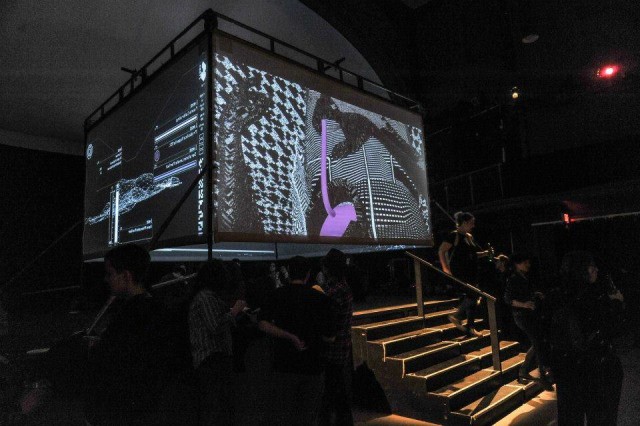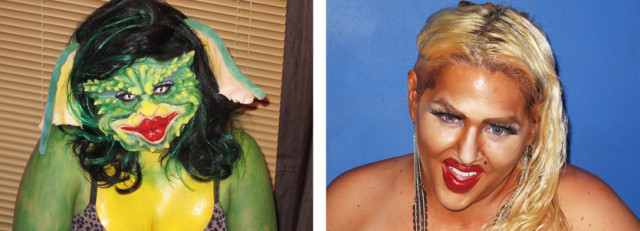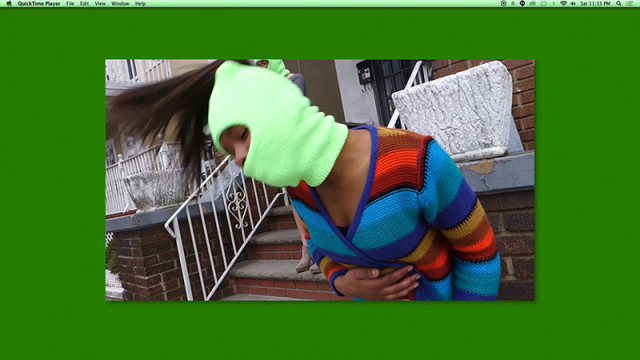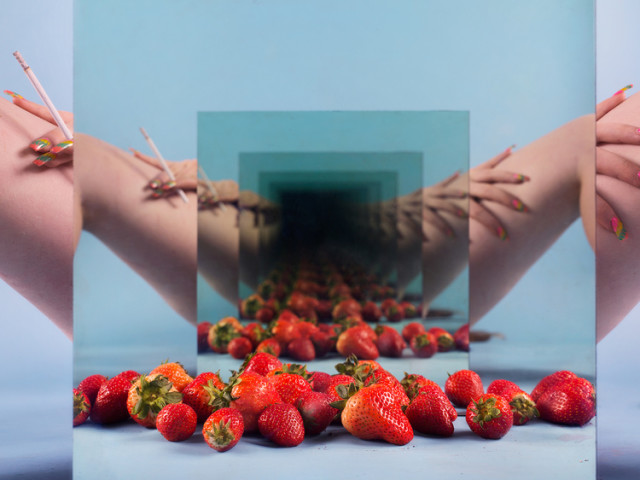As 2015 comes to a close, the internet is awash with “top 10” and “best of” lists. But one art world metric of success that’s under-discussed (and nearly-universally sought) is gallery representation. So we’ve asked past and present AFC editors to weigh in on the artists that commercial galleries haven’t snagged exclusive contracts with yet—despite acclaim from critics, museums, and audiences. In the interest of gender parity in the notoriously sexist world of gallery representation, we’re each selecting one male-identified and one female-identified artist.
To that end, here are the best and brightest boys and girls who’ve yet to be drafted
PADDY JOHNSON
Best Unrepresented Female Artist: Sondra Perry
Let’s face it: it’s only a matter of time before Sondra Perry has gallery representation. The young video and performance artist is coming off a solo show at the non-profit Recess, has been accepted into the Core Program in Houston, and has had her work included in the Greater New York Show. She graduated from the Columbia MFA program this May. These accolades exist because her work is smart and needed. Earlier this year, I reviewed Perry’s 25-minute “Lineage for a Multiple-Monitor Workstation: Number One”, a single channel video that invites users to reimagine black identity and social history. She casts her relatives as themselves and asks them to draw on and fabricate personal history. It’s a poignant, touching video that deserves all the attention it will get and more.
Best Unrepresented Male Artist: Dmitri Obergfell
I’m cheating with my pick of Dmitri Obergfell; he’s represented by Montoro12 in Italy, Gray Contemporary in Houston, and Gilder Gallery in Denver. But, he doesn’t have representation in New York, and I’ve been looking for an excuse to talk about his work since I visited his studio at Redline in Denver this November. I haven’t stopped talking about his work since. During that visit, Obergfell spoke about his interest in common images—iconography that remains in cultural consciousness for hundreds of years or more. It’s not surprising, then, to see maps, skulls and figurative sculptures from Greek and Roman antiquity in his work. In the image above, a graphite cast of a bust is used to create an abstract drawing, thus literalizing the effect of time and history on representation. As Obergfell sees it, no image is safe from progress.
CORINNA KIRSCH
Best Unrepresented Female Artist: Sara Meyohas
I can’t believe Sara Meyohas isn’t represented by a gallery yet. She will be, in 2016. This past year, after receiving her MFA from Yale, her accolades have been plenty: Meyohas’s Bitchcoin project received a ton of press, she opened up an apartment gallery on the Upper East Side, and now she’s created some sort of gold-nanoparticle paint with the help of a chemical engineer at MIT. There’s a strange techno-mysticism in her work as it regards the financial markets. With Bitchcoin, for example, it’s not just that an unframed archival chromogenic print is made for every BitchCoin, but that it gets locked in a bank forever. It operates like the gold standard, except of course, that we normally don’t place objects made to be seen in shroud of secrecy.
I’m going to continue following her, not because I completely get where she’s coming from, but because there’s a brave glimmer of alchemy in her art as it means to take control over the financial markets. That’s an important reversal of the hopelessness we can feel looking around the auctions and fairs, which seem to be completely driven by the market.
Best Unrepresented Male Artist: Ivan Picelj (1924-2001)
Picelj was a longtime member of the Zagreb-based artist group the New Tendencies. A designer, artist, and overall visual experimenter, Picelj’s works often engage with technology on the quantum level; many of his works contain small circles, that were meant to evoke electrons and other newly discovered visual minutiae. Until January 3, one of his exhibition catalogue covers will be on view in Transmissions: Art in Eastern Europe and Latin America, 1960–1980 at MoMA. There’s not a lot of work to see but it’s a bigger deal than you’d think. Sadly for us in the States, the majority of his works have been acquired by the Museum of Contemporary Art Zagreb (MSU). Thus MoMA recently received collection of his posters and other works on paper is pretty momentous.
REA MCNAMARA
Best Unrepresented Male Artist: Peter Burr

Peter Burr, “CAVE EXITS” (Installation View, via John Also Bennet).
Peter Burr’s “CAVE EXITS” at Toronto’s Images Festival stood out more than any other this year. The four-channel video cube mimics an old-school video game labyrinth with an animated environment inspired by Andrei Tarkovsky’s 1979 masterpiece Stalker. It’s a completely enveloping and even claustrophobic experience. Visitors sit inside the cube, and watch dark landscapes and buildings pan across all screens thus creating a Plato’s Cave of gradient fissures and dizzying patterns of exposed hardware coding.
The Brooklyn-based artist’s work appeals to me because it challenges the scope of the projected digital image. Burr has told AFC that his project will take more than 10 years to program in its entirety. These installations are ultimately small scale versions of one of the most complicated and immersive programming projects executed to date. Burr’s project will be to video game art what James Turrell’s “Roden Crater” is to land art.
Given this, I’m surprised an institution or commercial gallery hasn’t given the installation the white cube treatment. There’s enough value in Burr’s ambitious live experiences, that collectors and museum visitors alike need to be able connect with it.
Best Unrepresented Female Artist: Helen Cho
Helen Cho’s work has a slow burn appeal. On the times I visited her See Object Paper Hesitation solo exhibition at G Gallery, I found myself drawn to its humbling details: the sensual, elemental curves of unfired clay objects arranged on a gold vinyl-covered low bench, all of which gradually dwindled during the exhibition run because they were on offer in a small paper bag to passersby at the gallery’s front door. The objects seemed as though they were in constant flux.
The central piece, a video entitled “Tai Lam: Memory of Hunger Finds Its Form,” was direct in observing its immigrant protagonist feed pigeons in an abandoned chain-linked back lot in downtown Toronto—a 15 year ritual observed daily during breaks from working in the pizzeria next door. Cinematic, despite being shot on an iPhone, his balletic arm swing spraying bird feed in the air for the flapping pigeon swarm was a freeing, clear-eyed snapshot by the Korean-born Canadian artist. After years abroad living and working in Berlin, she recently returned to her hometown in Toronto.
All the works felt naked and intimate, especially because they come from a mid-career artist unearthing a new body of work. Cho expands into video and performance, touching on themes that felt urgent and relevant: immigration and displacement, but also a questioning of the value systems that define art object-making.
MICHAEL FARLEY
Best Unrepresented Female Artist: Jaimie Warren

Jaimie Warren, “Self-portrait as Female Gremlin/Self-portrait as rapper Lil’ Kim in Female Gremlin Totally Looks Like Lil Kim by iworejungleboots”
Of course I would pick Jaimie Warren as the best unrepresented female artist of 2015, because she is both biologically female and totally embodies everything I love about drag queens. Warren assumes a cast of characters harvested from pop culture, art history and internet memes—gleefully documenting herself in absurd point-and-shoot tableaus or performances inspired by others’ collages. There’s heady discussion that could be had here about appropriation, gender, authorship, or cultural studies—but mostly her work is just fun. Jaimie Warren is like a walking hug.
This year alone she’s shown at Artspace Raleigh, American Medium, Higher Pictures, Spritmuseum Stockholm, was the subject of an Art 21 special, and was a resident artist at the Abrons Art Center in the Lower East Side. On top of all this, she tours her non-profit kid’s variety show Whoop-Dee-Doo all over the world (full disclosure: I’ve participated in that program) and pops up in more publications and performances than I could ever keep track of. I hope the market never sucks the endearingly crafty, DIY/crowdsourced aesthetic out of her practice. Warren’s transformations offer a model of what Richard Prince should have been using social media for.
Best Unrepresented Male Artist: Wickerham & Lomax
My pick for best male artist is acrually two dudes, who often address each other as “gurl!” We screened Wickerham & Lomax’s “Take Karaoke: A Proposition for Performance Art” at our F.A.G. Bar pop-up at The Artist-Run in Miami this month, and every time it looped we found something new to love about the piece. That speaks to Daniel Wickerham and Malcolm Lomax’s capacity to pack more carefully-considered detail and content into their work than any other artist I can think of. It’s difficult to describe their practice, which spans interconnected narratives and networks of associations that carry over from one project to the next. Installations, web-based work, sculptures, and video might feature recurring characters set in a semi-mythological, cyberpunk vision of Baltimore. Variations of those characters might pop-up again in a fan-fiction webverse for a queer crime drama that only exists in promotional material, or larger-than-life banners that recall dystopian fast-fashion advertising campaigns.
And 2015 has been a banner year for the pair, who won the $25,000 Sondheim Prize and presented their work at the International Symposium on Electronic Art in Vancouver, BC. This year they’ve also had solo exhibitions in Los Angeles, New York, Baltimore, and Brown University. Given that they have several museum shows, awards, and international press under their belts, it’s surprising they aren’t already represented by a gallery. Then again, their often institution-specific work might be difficult to translate to the commercial market—although they appropriate the language of consumerism, their work is often almost comically un-commodifiable. I’ll never forget an installation at the Contemporary Museum in Baltimore that featured hyper-customized personal effects frozen in an ice purse. As the purse melted throughout the exhibition, the trinkets were gradually released and plunked into a fish tank below—each one a clue to the piece’s narrative, slowly revealed by its own destruction.
WHITNEY KIMBALL
Best Unrepresented Male Artist: Jake Dibeler (with Macy Rodman and Billy Fortini)

Macy Rodman and Billy Fortini performing Jake Diebler’s “I Can Feel My Body Rotting Like A Peach Left in the Sun” at American Medium.
Imagine what it would be like to go through puberty forever, and you’ve more or less got the nightmare scenario depicted in Jake Dibeler’s “I Can Feel My Body Rotting Like A Peach Left In The Sun.” Genderqueer body-loathing plagues his performers (both of whom introduce themselves as Jake Dibeler, both in long redhaired wigs and various stages of gendered dress). They describe Jake Dibeler, respectively, as a “performance artist from Alaska currently transitioning to a woman,” followed by a “free-spirited marijuana-harvesting genderfluid experimental dancer from Massachusetts.” The first is a seductive, pissy comedian dancing in a see through skintight dress with the crazed look of somebody contemplating murder suicide and dying onstage with AIDS jokes; the second is a slightly more confident iteration in combat boots, mocking performer #1 in a whiny voice. We laugh at the pubescent angst when Jake 1 falls on the walls screaming “No I’m okay! No I’m okay!,” itching her arms like she’s literally crawling in her own skin. We also crack up when the performers spray paint a middle finger on the wall, but the jokes are at her own expense, and Dibeler manipulates the comic rhythms masterfully. The art is in the pauses, a deeply sad and uncomfortable silence. It’s brutal. You can watch the whole thing here.
Best Unrepresented Female Artist: Jibz Cameron
It’s a little ridiculous to put Jibz Cameron on the “under-known” list because of her hardcore cult following, and she’s been performing since 2001, at places like the Kitchen and BAM. But for reasons beyond my explanation she’s not on the mainstream gallery circuit. I guess there are people who would not describe an abrasive screaming lady with crazy hair in a nude bodysuit and matching fannypack as their cup of tea. Fuck those guys.
Jibz Cameron’s alter ego Dynasty Handbag is a long lasting symbol for the weirdos and losers of the world, like when she presented her life’s artistic struggle as a journey up her own vagina and through her mouth earlier this year in her one-woman play “Soggy Glasses: A Homo’s Odyssey.” (A basic primer for tone: watch her perform Beyoncé). This is what untelevised lesbian culture does and should look like– which, in fact, came up in her recent saga to get a TV show on Cartoon Network. The whole thing went to shit, and she documented it hilariously in this new comic “The Dynasty Handbag Show: Or How Not to Make It in Showbusiness.” And yay, because TV won’t love her like we do.









Comments on this entry are closed.